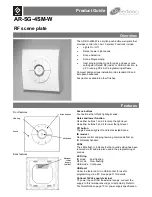
GSM/GPRS Module Series
M66 Hardware Design
M66_Hardware_Design Confidential / Released 13 / 80
1)
When the module works within this temperature range, the deviations from the GSM specification may
occur. For example, the frequency error or the phase error will be increased.
Table 2: Coding Schemes and Maximum Net Data Rates over Air Interface
Enhanced Full Rate (ETS 06.50/06.60/06.80)
Adaptive Multi-Rate (AMR)
Echo Suppression
Noise Reduction
UART Interfaces
UART Port:
Seven lines on UART port interface
Used for AT command, GPRS data
Multiplexing function
Support autobauding from 4800bps to 115200bps
Debug Port:
Two lines on debug port interface DBG_TXD and DBG_RXD
Debug Port only used for firmware debugging
Auxiliary Port:
Used for AT command
Phonebook Management
Support phonebook types: SM, ME, ON, MC, RC, DC, LD, LA
SIM Application Toolkit
Support SAT class 3, GSM 11.14 Release 99
Real Time Clock
Supported
Physical Characteristics
Size: 15.8±0.15 × 17.7±0.15 × 2.3±0.2mm
Weight: Approx. 1.3g
Firmware Upgrade
Firmware upgrade via UART Port
Antenna Interface
Connected to antenna pad with 50 Ohm impedance control
Coding Scheme
1 Timeslot
2 Timeslot
4 Timeslot
CS-1
9.05kbps
18.1kbps
36.2kbps
CS-2
13.4kbps
26.8kbps
53.6kbps
CS-3
15.6kbps
31.2kbps
62.4kbps
CS-4
21.4kbps
42.8kbps
85.6kbps
NOTE
Quectel
Confidential















































